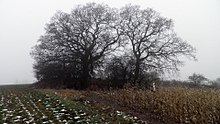Passage grave Lille Selle
The passage grave Lille Selle (also called Egeløkke or Egelykke) is located west of Bøstrup, on the Danish island of Langeland . The megalithic system of the funnel beaker culture (TBK) originated between 3500 and 2800 BC. Chr.
description
The Langdysse has two west-east oriented, rectangular passage burial chambers . The south side of the megalithic bed is defined by five small curbs in a straight line. The other contours of the mound are not detectable. Several larger, displaced stones lie on the surface of the hill.
The eastern chamber consists of ten in situ supporting stones and measures around 5.0 × 1.7 m inside. All three cap stones are missing. The corridor, which opens to the south, can be reconstructed to a size of 3.0 × 1.2 m without large stones, but by tiling the dry stone walls .
The western chamber also consists of ten bearing stones in situ and measures around 5.0 × 1.9 m inside. The end stone on the east side is missing, as are the cap stones. In the corridor opening to the south there is a larger stone on the west side, but it is hardly original. In addition, a stone slab layer can be seen on the west side of the corridor, as in the east chamber. There is no lithic marking on the east side, but depending on the shape of the terrain, the corridor width may have been about 1.1 m.
See also
literature
- Ingrid Falktoft Anderson: Vejviser til Danmarks oldtid. 2nd Edition. Gads Forlag, Århus 1994, ISBN 87-89531-10-8 .
Individual evidence
- ↑ Langdysse is the name commonly used in Denmark for dolmens that lie in a rectangular or trapezoidal barn, in contrast to round dolmens or round dysers are those dolmens that lie in a round hill
Web links
Coordinates: 55 ° 2 ′ 29.4 " N , 10 ° 52 ′ 5.8" E

